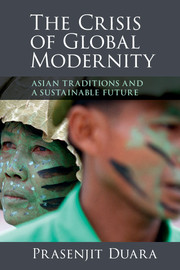Book contents
- Frontmatter
- Epigraph
- Contents
- List of figures and maps
- Preface and Acknowledgements
- Introduction
- 1 Sustainability and the crisis of transcendence
- 2 Circulatory and competitive histories
- 3 The historical logics of global modernity
- 4 Dialogical and radical transcendence
- 5 Dialogical transcendence and secular nationalism in the Sinosphere
- 6 The traffic between secularism and transcendence
- 7 Regions of circulation and networks of sustainability in Asia
- Reprise and Epilogue: of reason and hope
- Bibliography
- Index
- References
6 - The traffic between secularism and transcendence
Published online by Cambridge University Press: 05 January 2015
- Frontmatter
- Epigraph
- Contents
- List of figures and maps
- Preface and Acknowledgements
- Introduction
- 1 Sustainability and the crisis of transcendence
- 2 Circulatory and competitive histories
- 3 The historical logics of global modernity
- 4 Dialogical and radical transcendence
- 5 Dialogical transcendence and secular nationalism in the Sinosphere
- 6 The traffic between secularism and transcendence
- 7 Regions of circulation and networks of sustainability in Asia
- Reprise and Epilogue: of reason and hope
- Bibliography
- Index
- References
Summary
The chapter explores the fate of religious practices and ideas in the realms of dialogical transcendence in nineteenth- and twentieth-century Asia when these traditions sought to adapt to the new models of religion emanating from the powerful West. They responded in two ways – sometimes combining both. The first was the confessionalization of religion built around the self–Other distinction, which was sensed as critical to survival and advancement of nations in the new world.The second was the development of the modern realm of spirituality as a source of self- and collective formation that often accompanied the demarcation of the secular from the religious spheres.
In the last chapter we saw that the binary of religion and secularism developed from modern Western histories cannot quite capture the distinctiveness of Chinese religious and political experiences. Here by developing the idea of ‘traffic’ between the religious and secular spheres, I hope to grasp the impact of secularization more meaningfully. Accordingly, I will discuss the recent debates about secularism and then proceed to analyze several episodes, practices and figures in modern Asian history to illustrate how the transcendent and other religious ideas often do not disappear but, rather, migrate into different spaces and institutions with sometimes remarkably generative and equally constraining effects in the moral, social, political and even, environmental spheres (explored in the last chapter). The static binary upon which much social theory of the modern has been constructed has to be rendered mobile in order to grasp new possibilities for a sustainable world.
- Type
- Chapter
- Information
- The Crisis of Global ModernityAsian Traditions and a Sustainable Future, pp. 195 - 238Publisher: Cambridge University PressPrint publication year: 2014



